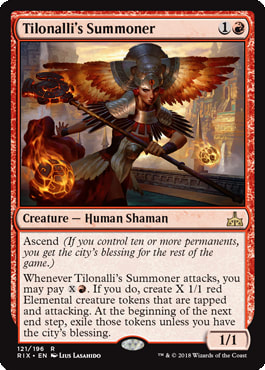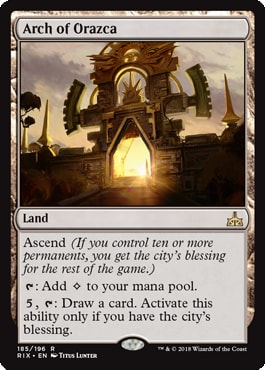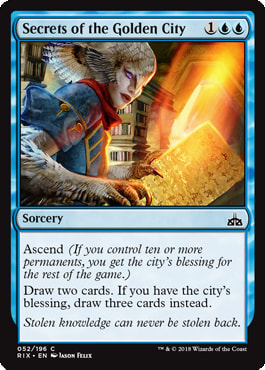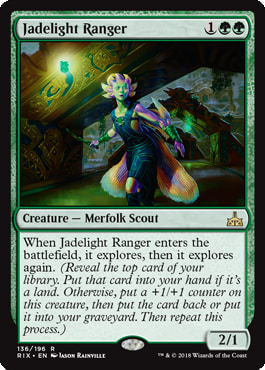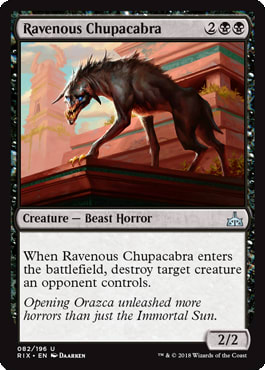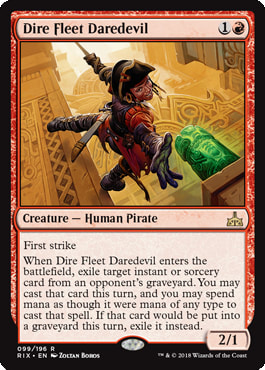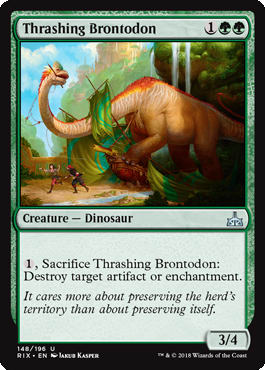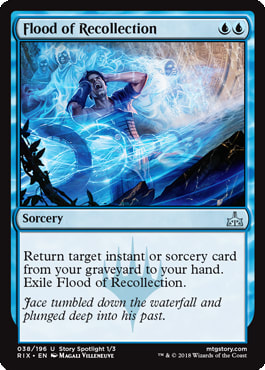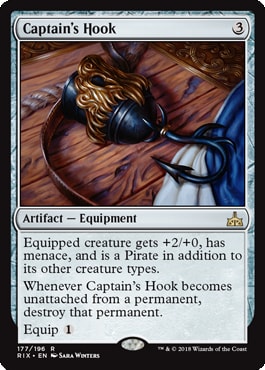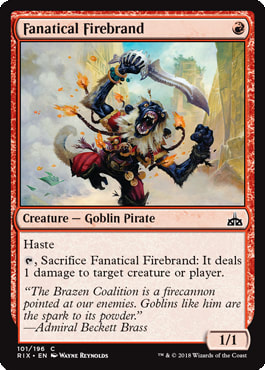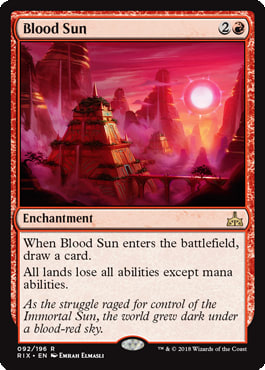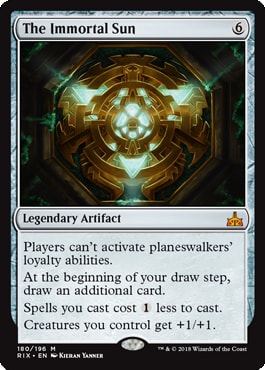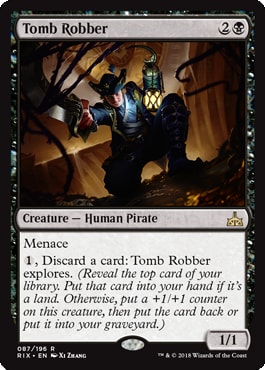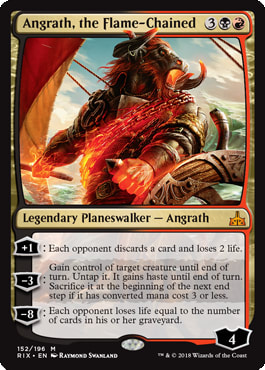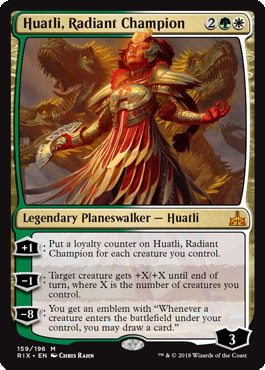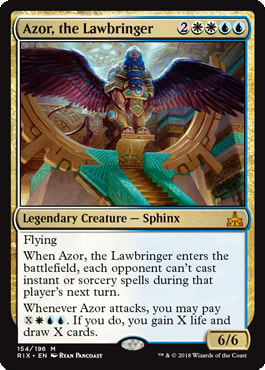Rivals of Ixalan looks like it's a pretty weak set for Cube, but there still looks to be some solid additions for Cube with several underrated cards in the set.
Of note: As usual, know that these evaluations are based on actual play in my Cube and not merely outsourced to speculation, seeing them in Standard, going to a prerelease, or from limited play. If I'm saying a card has been working well based on my experience, it's based on actual experience from trying them out in my Cube and finding the cards have been working well/poorly, and your cube experience should be similar.
Ascend
The only new mechanic in the set is Ascend, a mechanic that appears to reward either going wide or going for a long game to hit 10 Permanents, and the first thought for many is do-nothing board states that define slow Limited formats, where walls of creatures look at each other like an awkward middle school dance.
I've found that cards like Burst lightning, Shriekmaw, and Unexpectedly Absent -- flexible cards that can be played in multiple decks and at different modes -- live and die by their ability to have a good "base mode" that effectively works with a deck's game plan. The cards that have succeeded in that role do so by addressing a Cube decks' goals, whereas something like Wildest Dreams doesn't, since it doesn't have a good base mode. Ascend's cards have worked similarly, where going to 10 Permanents is easier than you'd think, but isn't something that you can always rely on happening, so Ascend cards need to be good without needing to hit Ascend.
The most obvious Ascend card for Cube is this format's 2/1 for 1 with an upside, Skymarcher Aspirant.
Cards like Dragon Hunter, Mardu Woe-Reaper, Dryad Militant, and Soldier of the Pantheon have some boons on top of their Savannah Lions stats. Over the years, I've found these boons to only occasionally come up, and if the boon on Dragon Hunter, Mardu Woe-Reaper, Dryad Militant or Soldier of the Pantheon didn't come up in a relevant manner in a draft, let alone in a month of weekly Cube drafting, it isn't much of a surprise.
Even without the help of token generators, there were several times when on something like turn five, Ascend would happen with a board state featuring Skymarcher Aspirant. I found that while it wouldn't happen every game, it happened more frequently than the boons on the aforementioned lions, on average, in a 3-match draft.
It's also been nice since its boon of turning into a flier helps to get around one of the inherent weaknesses of these types of cards -- where it gets outclassed on the ground during the later stages of the game. The boon on cards like Dragon Hunter don't matter much, even if there's a dragon out. While White aggro decks may not want to be in the late stage of the game, cards like this, Thraben Inspector, and Kytheon, Hero of Akros help for those stages of the game. Because of this, I've found it to be, Kytheon and Isamaru aside, the best Savannah Lions in the format. While it's not a flashy card, it's a great and easy add for Cube.
On the other end of the spectrum is Vona's Hunger, a card that performed poorly, much like Doomfall, since three mana was a bit too pricey for the base mode of an edict. Twilight Prophet, Wayward Swordtooth, Tendershoot Dryad, and Expel from Orazca suffered a similar fate, for being unacceptably under-rate without Ascend with its Azure Drake stats.
Tilonalli's Summoner operates in a weird middle ground where it isn't a typical 2-3 power creature for two that aggro decks want, and it's a bit low impact for non aggro Red decks. I've found that it's nice if it can survive a combat step, since activating for X=5 usually means that the tokens live and it can snowball from there. It doesn't have a second power and thus its body is anemic and a poor topdeck, making it hard to justify in Cube.
Arch of Orazca is a bit too mana intensive, even for control decks looking to go long that have no problem getting ascend on just lands, mana rocks, leftover value creatures and a planeswalker or two. While, in theory, it could be used in control decks that could hold up counterspell mana and, if the opponent didn't cast a spell, Arch would draw a card, but even in those decks, five mana plus tapping arch was just too high a mana cost.
Secrets of the Golden City was a surprisingly great generic draw spell, and usually was a cheaper Concentrate for control decks that sought to go to the late game. If it only ended up drawing you two cards, that wasn't too bad either. This card, overall, performed better than some of the other Ascend cards like Arch of Orazca, since Divination wasn't a terrible worst-case/base mode on this type of effect where other things like Arch of Orazca and Vona's Hunger don't tend to work well on their base modes in Cube decks.
However, many Cubes aren't looking for yet another Blue card draw spell and you may find room for this in your Cube, since, as good as it is, it's arguably not as good as cards like Thirst for Knowledge. That said, when you're considering options for your Blue section, don't dismiss this.
Others
Admiral's Order is another in the recent iterations of a 3-mana counterspell with some form of upside. Many years ago, Matt Kranstuber talked about introducing Blue tempo as an archetype for Cube to provide Blue with some variety. In these kinds of decks, Admiral's Order really shines as a way to deploy a threat and cheaply protect it. Generally 3-mana counterspells that fare best in Cube offer some kind of incentive for paying three mana, whether it's buyback, Forbid, or scry, Disallow, rather than allowing for flexibility. Because of this, this makes it a role player, but one that's not super embarrassing to play in a control deck. It's still likely going to have a hard time making it into a Cube.
Jadelight Ranger. It's tempting to outsource to other formats, saying that "all explore cards are bad" because cards with explore haven't made impact in Standard, as of the time of this article, but this is reductionist logic and dismisses cards like Jadelight Ranger -- a value powerhouse. While you can't control what it does, and it's easy to dismiss this because you can't directly control the outcome, it does a whole lot. Drawing 2 lands, depending on the deck, can be a bit of a letdown, but generally the decks that have enjoyed it are able to use it like most Jund-y cards, as a way to get card advantage and value. It's also worth noting that seeing a non-land card on the top of your library can easily make it a 4/3 and, while a three mana 4/3, isn't usually in the game plan of Green midrange and ramp, depending on the matchup, it closes out games very quickly if unanswered and blocks 2/2s all day.
Rekindling Phoenix is a 4-mana creature that doesn't have immediate impact via something like haste or an enter-the-battlefield trigger. That's a rough sell in Red decks, but it's much better than you think. Since it doesn't truly die unless the 0/1 is killed, it either requires specific answers, a la exile effects like Swords to Plowshares, several removal spells, or chaining trading in combat with a removal spell.
Because of this, trading in combat with Rekindling Phoenix generally isn't worth it. I found many times when the Phoenix was the primary threat, if an opponent was holding a removal spell and unable to really do anything with it, they were forced to either chain another removal spell or hope to win the game outside of dealing with it. Since it doesn't have haste, it doesn't fill the role of traditional Red curve topper like Hellrider or Hero of Oxid Ridge, but that doesn't necessarily make it a bad card. It just serves a different purpose as a resilient threat (that works well with symmetrical removal like wraths and Wildfires) and has surpassed expectations and while it looks like a card that can be safely dismissed, it's a good one to at least try out.
Ravenous Chupacabra is a very good card and a pretty obvious add as a better Nekrataal and Skinrender, although its body is worse than all of them. Even in space-constrained Cubes, it shouldn't be too hard to find room for this as it works well in all Black decks. I've found that it being able to hit either a Black creature or an artifact creature generally comes up at least once during a 3-match event. Your primary instinct may be to remove either Nekrataal or Skinrender, but as I've noted in previous articles, sometimes the better add isn't the easiest and putting forth some more effort in changes can result in a better cut.
Dire Fleet Daredevil -- one of the classic tales of card evaluation traps comes from Mark Rosewater when he talked about Kavu Titan, a creature that was Grizzly Bears but could be kicked to be a 5/5 trampler for ![]()
![]()
![]() .
.
During my last match, Randy watched. At some point late in one of the games, I played my Grizzly Bears. After the match was over, Randy informed me that the Grizzly Bears weren't actually Grizzly Bears. They were proxies for Kavu Titan. Armed with this information, the next week I went 2-2. Suffice to say that the R&D guys thought this was the funniest thing ever. The lesson I learned was the importance of using the Kavu Titans as 2/2s. When I was aggressive with Kavu Titan, my deck performed much better. When I waited to maximize the Kavu Titans as 5/5 creatures, I lost much of the aggression of my deck and thus some of its power. Week 3, I went 4-0 again.
For Red aggressive decks, it's correct more often to play this as a Youthful Knight than you'd think. It's also easy to fall into the trap to dismiss this because it's not Snapcaster Mage -- Torrential Gearhulk was incorrectly dismissed by many because it looked bad compared to Tiago Chan as the giant Blue robot couldn't flash back sorceries, while ignoring Torrential Gearhulk's upsides (it's huge and the flashed back spell is free.) The best uses have been to get low-cost and highly efficient cards like Preordain, Go for the Throat, or Abrade and as a way to act somewhat similar to kicker as a way to get value in the late game. Although you can't rely on an opponent using a spell, I've found that happens over the course of the game naturally. Much like Rekindling Phoenix, this doesn't fit the preconceived role of a Red aggro beater (although it certainly can and does play that role just fine), but it's a flexible card that is an overall solid, but not absurd, Red creature and should play nicely in your Cube.
Champion of Dusk -- the best tribal cards in Cube generally need to be good on their own, like Pack Rat, Goblin Rabblemaster and Avenger of Zendikar, which is something I talked about in the Commander 2017 review. Cards like Heirloom Blade work without requiring linear tribal synergy, but cards like New Blood fail because they do. Because of this, even with getting good vampires in recent years like Gifted Aetherborn, Asylum Visitor, Kalitas, Traitor of Ghet, and Drana, Liberator of Malakir, making a "vampire deck" just doesn't work in Cube. Because of this, Champion of Dusk is, at his absolute worst, a giant Phyrexian Rager (or a non-draw if killed in response to the trigger) but one that can have some great upside if the stars line up. Overall, its average mode was merely ok; and, much like a lot of mediocre cards in their respective mana slot, it's mostly something to have until something better comes along for many Cube designers.
Grasping Scoundrel is better than the 2/x for ![]() creatures with drawbacks and no bonuses, like Sarcomancy, Carnophage, Vampire Lacerator, and Reaver Drone but worse than ones with benefits like Gravecrawler, so, much like Unstable's Hangman and Masterful Ninja, it's useful if Black aggressive decks are good decks in your Cube.
creatures with drawbacks and no bonuses, like Sarcomancy, Carnophage, Vampire Lacerator, and Reaver Drone but worse than ones with benefits like Gravecrawler, so, much like Unstable's Hangman and Masterful Ninja, it's useful if Black aggressive decks are good decks in your Cube.
Slaughter the Strong is an interesting wrath variant at less than four mana, but still leaves some things hanging around, which I found to be too awkward for Cube. It can be fine in decks that have a 2 or 3 power creature backed up by protection, but it's a niche role for a wrath.
Warkite Marauder is a card that would likely be a staple if it was a White card, as a way for aggro decks as a way to invalidate blockers. It also makes the plan of playing something big like a titan, stabilizing with it, and riding it to victory harder since it makes holding back blockers incredibly awkward and even works well with cards that ping off small creatures like Chandra, Pyromaster, Liliana, the Last Hope, Umezawa's Jitte, Wretched Confluence, and others to turn a Wurmcoil Engine into a Goat token. However, Blue control decks aren't in the market for a strictly attacking card since most Blue decks in Cube tend to be of the control variety (and this is nearly useless in those decks, rendering them unitaskers like Admiral's Order) although it's solid in Blue decks that spend a good amount of time in the red zone, like tempo and even some flavors of midrange.
Because of Blue's nature, this may be hard to put into your Cube. Think of other recent 2/1 fliers for two with upside in Blue, like Dimensional Infiltrator and Skyship Plunderer and how good they are, objectively speaking, and how their Cube adoption rates are low. This, however, is the best iteration of a 2/1 Blue flier that we've seen in a while, and if you want to have something for your Blue decks that isn't just control.dek fodder, it's worth a whirl.
Thrashing Brontodon gets a bit of a bad rap due to being unfairly compared to creatures that kill artifacts when they enter the battlefield like Manglehorn and Viridian Shaman. As mentioned before, cards like Torrential Gearhulk were underestimated by focusing on what the card doesn't do, while losing focus on what it can do. In this case, dismissing Thrashing Brontodon dismisses that this is a big beater. Like with Jadelight Ranger, Green isn't as much in the market for 3/4s for three as other colors like Red, White and Black, but it's still a solid body for a utility creature, more so for a color that can easily power it out on turn two.
Being an onboard removal effect makes it so that an opponent won't just run a prized artifact or enchantment into it unless it's worth having Thrashing Brontodon gone, but this also makes it so that it's able to be used proactively as a creature without something needing to be in play, like Uktabi Orangutan and friends (while it can be done, it's generally a sign that things have gone horribly wrong). This makes it much easier to maindeck. Green doesn't have a lot of stone-cold staples, but a roster of solid 3-drops: Nissa, Vastwood Seer, Yavimaya Elder, Courser of Kruphix, Manglehorn and others, and like Jadelight Ranger, this is a great card to supplement those.
Flood of Recollection is a slightly improved take on Call to Mind, but it's still a bad Regrowth and a weak card unless you're going incredibly deep on combo.
The 6-card cycle of the dinosaur legends unfortunately pale in comparison to other big-mana finishers, closer to Magic 2015's Soul cycle than the Titans, as they're mostly too much mana for the effort. Tetzimoc is the best of the bunch as a pseudo-Plague Wind that makes use of extra mana during turns 1-5, but it's still yet another middling 6-drop in Black. Nezahal is a fine control mirror breaker that can feed its flicker ability on its own, but it's another card outclassed by its better competition. Zetalpa doesn't die to (a significant chunk) of removal, but it's just too much mana for too little board impact, and even for decks like reanimator, there are better things that control decks would want to play.
Captain's Hook competes with a lot of powerful equipment as a 3-mana equipment but it just doesn't do much for the cost even without considering its usually irrelevant drawback. That said, menace does make creatures with evasion, like flying, nearly impossible to block, so it does play better than you may think, but it still ended up not being maindecked very much, so I'd only tepidly advise trying it out in your Cube.
Fanatical Firebrand is a riff on Mogg Fanatic and is generally a better topdeck for being able to wield equipment, but is worse at incidental damage if it dies in combat. Usually the 1 damage that Mogg Fanatic dealt when sacrificed in combat, with or without damage on the stack, was a nice little bonus to dome the opponent for 1, but was hardly game breaking. We're living in a world with much better aggro beaters than this in Cubes, aside from Pauper, which has a lack of depth for good aggro 1-drops (and thus, this will easily find a home in Pauper cubes) so this will have a hard time finding a home in non-pauper cubes.
Blood Sun just doesn't do enough, even with a cantrip attached.
The Immortal Sun is a card similar to cards like Caged Sun that offer a big potential impact by boosting your threats, but not doing that much on its own. The symmetrical nature of it hitting both players' planeswalkers can make it so that it has a similar effect to symmetrical removal for things like creatures. It's a bit harder to rely on your opponent having some to stop, although its individual modes are nice where drawing an extra card, an anthem, and a cost reduction is worth more than six mana, but it's still a pretty big cost to put forward, especially since decks that seek to use The Immortal Sun don't tend to have a lot of creatures. If you find that your meta is such that planeswalkers are taking over your Cube, this may be worth a try, but other cards like Pithing Needle and Sorcerous Spyglass and adjusting your Cube's meta perform this role much better.
Induced Amnesia is not bad as a card that emulates draw-7s like Memory Jar and Timetwister, but it loses out on the best part, being able to throw away an empty hand to draw 7 new cards. Having you trade evenly for cards makes it provide no cost advantage, which is poor even if it doesn't make the opponent get a new hand. In a color with great things, this is only mediocre.
Tomb Robber is somewhat of a looter variant, a way to quickly dump things into the graveyard to potentially become huge, but the cost of one mana is a very real cost and generally these effects tend to be underestimated in terms of their cost. It's also a really bad topdeck, requiring significant resources to be a sizable threat, even with menace, make this something that I wouldn't recommend.
Multicolored
Journey to Eternity gives some great payoff for decks that can reliably sacrifice creatures. Golgari decks tend to have a good amount of Mulldrifters, creatures that have value outside of the body of the creature and can grind out resources so well that ![]()
![]()
![]() cost and tapping a land isn't too bad. However, as clich� as it sounds, there's rough competition in multicolored. The other multicolored flip enchantments give too little payoff for the resources used to flip them, like Profane Procession's mana cost or Path of Mettle's deck constraints.
cost and tapping a land isn't too bad. However, as clich� as it sounds, there's rough competition in multicolored. The other multicolored flip enchantments give too little payoff for the resources used to flip them, like Profane Procession's mana cost or Path of Mettle's deck constraints.
Angrath, the Flame-Chained is an arguably improved take on Liliana Vess, who was best in used in Cube as a control mirror breaker as a way to shred an opponent's hand. Arangath's 2 damage lets it emulate Sulfuric Vortex in a way, deal with him or lose, but his other abilities are pretty mediocre. He can arguably be used as a curve topper, like Sarkhan Vol, stealing an opposing threat and pressuring an opponent; but, he's still a bit too pricey for Cube and doesn't protect himself very well. Rakdos has some hard competition -- Kolaghan's Command, Daretti, Ingenious Iconoclast, Terminate, Dreadbore, Rakdos Cackler, Fulminator Mage, and Murderous Redcap, so it's likely not going to do much in your Cube.
Huatli, Radiant Champion is a poor planeswalker as she doesn't protect herself very well. If you set it up, you can activate her +1 with a lot of tokens and then ultimate, but even that's a bad reason to play Huatli. Much like the previous Huatli, this doesn't have much of a home in Cube.
Lastly, Azor, the Lawbringer is awkward. A 6-mana creature that will likely win the game if you untap with it and get to attack is awkward; but, provided the coast is clear, it can get the job done. In the Unstable review, I talked about how 6-mana creatures that don't do anything when they enter the battlefield but are absurd if you can untap with them don't tend to fare that well in Cube, since killing them puts their controller at a massive tempo disadvantage. However, Azor's ability to stop instants and sorceries helps to an extent, mostly for stopping sorceries as the instant protection can be responded to and they can use instants on your turn to try and deal with him. It can play the part of a miser's Xantid Swarm, but those kinds of combo decks don't usually want to tap for ![]()
![]() very often. In a color combination with things like Sphinx's Revelation (which is better than this) and other control and tempo cards, this just doesn't do enough and fills the role of late-pick card that may end up making the deck, similar to 3-color dragons in Cubes that ran them.
very often. In a color combination with things like Sphinx's Revelation (which is better than this) and other control and tempo cards, this just doesn't do enough and fills the role of late-pick card that may end up making the deck, similar to 3-color dragons in Cubes that ran them.
My blog, featuring my Pauper and powered Cube lists.
Cube podcast, The Third Power, that Anthony Avitollo and I host.
Find me on Twitter @UsmanTheRad
















